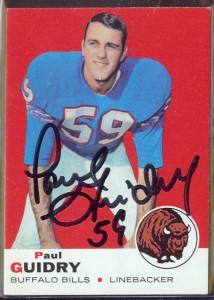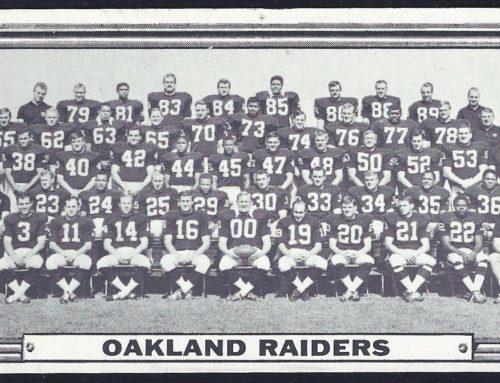Paul Guidry was drafted out of McNeese State University by the Buffalo Bills, in the eighth round of the 1966 AFL Draft. Guidry was aa solid performer for the Bills, playing from 1966-1972. He played one more season for the Houston Oilers in 1973, before retiring from the game.
AFL – Please describe your first professional training camp. What was the competition like? What are your strongest memories from that camp?
PG – It was July, 1966. I flew into Buffalo International and was picked up by a Buffalo Bills employee and taken to the camp site in Blaisdell, NY, near Buffalo. We stayed in a motel and practiced on a converted field behind the motel. Competition was modest, no other linebackers to speak of, being that Buffalo was coming off of two AFL Championships and had six proven linebackers. As the training camp weeks went by, and the red message light on the telephone stayed unlit – lit meant, bring your playbook to the office, as you were released – I knew my stock was rising. On the last day and final cut day, I walked slowly to the dressing room and along the way, a group of veterans were waiting outside with hair clippers and laughing. One said, “come here rookie, and get your 40-man roster hair cut.” I had made the team and that hair cut was the best cut I ever got 🙂 You can imagine what it looked like from these professional barbers, and you know what, I wore the cut that way to our first game in San Diego.
AFL – Talk about the transition from college to the professional game.
PG – The transition was fairly easy, from playing the whole game in college at McNeese State University, tight end on offense, defensive end on defense, on kick-offs, and returns, punt and punt returns, etc. So the transition was mild in that I was mostly on special teams my rookie season.
AFL – What was your single proudest moment in professional football?
PG – As a 14-year-old kid in South Louisiana, the football player I idolized the most was Johnny Unitas of the Baltimore Colts. Now its 1970, in Baltimore, and I’m getting ready to face the Man, Johnny U. What a feeling to be on the same field as my hero! We lost the game, but I managed to step in front of a Johnny U. pass and intercepted his pass. I still have that ball, and managed to have Johnny sign it years later. By the way, I still have that ball prominently displayed in a glass case with one of Johnny’s card inside.
AFL – What team/opponent did you feel was the most challenging to you personally? Conversely, which did you feel you had your greatest success against?
PG – The most challenging was the Miami Dolphins and Butch Cassidy and the Sundance Kid, Larry Csonka and Jim Kiick. If you didn’t get enough of them, you had to deal with Bob Griese, and Mercury Morris. Conversely, I played my best games against Joe Namath and the Jets. With Emerson Boozer and Matt Snell and later on John Riggins in the backfield, games against the Jets and the battle for NY State Champions were brutal 🙂
AFL – You played both pre- and post-merger. Were there any noticeable differences for you between the two eras?
PG – The AFL was more of a wide open, man-to-man pass defense and the NFL was more of a conservative zone pass defense.
AFL – What was the most difficult part of leaving professional football? Missing the camaraderie of your teammates? The adulation of the fans? The transition into the “real world”?
PG – Pretty much all of the above, but most of all, that moment felt like the end of the world, meaning, from middle school football, you went to high school football, from high school you went into college ball, from college to pro and lastly, nothing after pro. It was ” over, ” a very big downer!!
AFL – What was the hardest collision that you were ever involved with on the field?
PG – Taking on Boston Patriots right guard, Len St. Jean, on a kick out block on the last play of the first half. I missed the second half with a mild concussion.
AFL – Who were the one offensive and one defensive player that you saw during your career that most impressed you? Why?
PG – Offensively: That would be Joe Namath, because Joe could really throw the ball accurately, faked the ball well, etc. Defensively: Dick Butkus was really impressive. He had no fear, busted heads, tore through lineman, punished backs driving them into the ground, etc.
AFL – How did it feel the first time you saw yourself on a bubble gum card? Had you collected cards as a kid?
PG – I was ” WOW ” this was the ultimate, I was on a card !!!” As a kid, we were poor and couldn’t afford that luxury, but other kids would show me their cards occasionally.
AFL – What did you do in your years post-football? What kinds of things are you doing now?
PG – Another player, Edgar Chandler, now deceased, and I invested in a restaurant, then another. I got out of that, was a supervisor for the Southland Corp. (7-Eleven Food Stores), and then went into the profession I trained for, teaching and coaching in high school. I became an assistant principal for a high school, and am now enjoying retirement.
AFL – If you could give current professional football players any single bit of advice, what would it be?
PG – I would advise them to finish college if they had not, save some of their money and invest some very wisely. Especially today’s dollars that players get, as compared to our time. We made very little money, and the reason most of us worked during the off-season.
AFL – Any other comments that you would like to make?
PG – Football pretty much opened doors to all that I have accomplished, and football also taught me to work hard, and never quit. It’s also rewarding when people like yourself want to have cards autographed, and putting older teams together with their sons and daughters or as a hobby. I thank you for remembering 🙂
I hope this helps and if you have any further questions, please do not hesitate to ask.
Thanks again,
Paul Guidry – Buffalo Bills 1966-72, Houston Oilers 1973



Todd- Paul is the older brother of Ron Guidry, correct?
Wow, I hadn’t heard that, John. They are both from Louisiana. I will find out and get back with you.
John… I posed your question to Paul in an email, and this was his response:
“Todd, I do know and have met Ron Guidry. In fact our home towns are less than 15 miles apart in South Louisiana, however, if we are related, and some of my relatives are trying to find out, it would be distant cousins, but nothing confirmed as of yet. The last name Guidry in S. Louisiana is like Smith anywhere else.
Paul”
Todd if you are able to contact Paul my name is Jim Wangler I met Paul in the late sixties and in fact my mother watched the Guidry children. I wore his number 59 all during high school. I would love to get in touch with him.
… [Trackback]
[…] Read More here on that Topic: talesfromtheamericanfootballleague.com/email-from-the-afl-buffalo-bills-paul-guidry/ […]
… [Trackback]
[…] Info on that Topic: talesfromtheamericanfootballleague.com/email-from-the-afl-buffalo-bills-paul-guidry/ […]
… [Trackback]
[…] Information on that Topic: talesfromtheamericanfootballleague.com/email-from-the-afl-buffalo-bills-paul-guidry/ […]
… [Trackback]
[…] Find More Information here on that Topic: talesfromtheamericanfootballleague.com/email-from-the-afl-buffalo-bills-paul-guidry/ […]
… [Trackback]
[…] Find More Info here to that Topic: talesfromtheamericanfootballleague.com/email-from-the-afl-buffalo-bills-paul-guidry/ […]
… [Trackback]
[…] Find More Info here to that Topic: talesfromtheamericanfootballleague.com/email-from-the-afl-buffalo-bills-paul-guidry/ […]
… [Trackback]
[…] Read More Info here to that Topic: talesfromtheamericanfootballleague.com/email-from-the-afl-buffalo-bills-paul-guidry/ […]
… [Trackback]
[…] Here you can find 11663 more Information to that Topic: talesfromtheamericanfootballleague.com/email-from-the-afl-buffalo-bills-paul-guidry/ […]
… [Trackback]
[…] Read More Info here on that Topic: talesfromtheamericanfootballleague.com/email-from-the-afl-buffalo-bills-paul-guidry/ […]
… [Trackback]
[…] Find More here on that Topic: talesfromtheamericanfootballleague.com/email-from-the-afl-buffalo-bills-paul-guidry/ […]
… [Trackback]
[…] Information on that Topic: talesfromtheamericanfootballleague.com/email-from-the-afl-buffalo-bills-paul-guidry/ […]
… [Trackback]
[…] Read More Info here on that Topic: talesfromtheamericanfootballleague.com/email-from-the-afl-buffalo-bills-paul-guidry/ […]
… [Trackback]
[…] Information to that Topic: talesfromtheamericanfootballleague.com/email-from-the-afl-buffalo-bills-paul-guidry/ […]
… [Trackback]
[…] Read More on on that Topic: talesfromtheamericanfootballleague.com/email-from-the-afl-buffalo-bills-paul-guidry/ […]
… [Trackback]
[…] Info on that Topic: talesfromtheamericanfootballleague.com/email-from-the-afl-buffalo-bills-paul-guidry/ […]
… [Trackback]
[…] Read More to that Topic: talesfromtheamericanfootballleague.com/email-from-the-afl-buffalo-bills-paul-guidry/ […]
… [Trackback]
[…] Find More Info here to that Topic: talesfromtheamericanfootballleague.com/email-from-the-afl-buffalo-bills-paul-guidry/ […]
… [Trackback]
[…] Info to that Topic: talesfromtheamericanfootballleague.com/email-from-the-afl-buffalo-bills-paul-guidry/ […]
… [Trackback]
[…] Find More on on that Topic: talesfromtheamericanfootballleague.com/email-from-the-afl-buffalo-bills-paul-guidry/ […]
… [Trackback]
[…] There you can find 76861 more Information on that Topic: talesfromtheamericanfootballleague.com/email-from-the-afl-buffalo-bills-paul-guidry/ […]
… [Trackback]
[…] Find More Information here to that Topic: talesfromtheamericanfootballleague.com/email-from-the-afl-buffalo-bills-paul-guidry/ […]
… [Trackback]
[…] Here you can find 17870 more Information on that Topic: talesfromtheamericanfootballleague.com/email-from-the-afl-buffalo-bills-paul-guidry/ […]
… [Trackback]
[…] Here you will find 28454 more Information to that Topic: talesfromtheamericanfootballleague.com/email-from-the-afl-buffalo-bills-paul-guidry/ […]
… [Trackback]
[…] There you can find 9925 additional Info on that Topic: talesfromtheamericanfootballleague.com/email-from-the-afl-buffalo-bills-paul-guidry/ […]
… [Trackback]
[…] Read More to that Topic: talesfromtheamericanfootballleague.com/email-from-the-afl-buffalo-bills-paul-guidry/ […]
… [Trackback]
[…] Read More to that Topic: talesfromtheamericanfootballleague.com/email-from-the-afl-buffalo-bills-paul-guidry/ […]
… [Trackback]
[…] Find More here to that Topic: talesfromtheamericanfootballleague.com/email-from-the-afl-buffalo-bills-paul-guidry/ […]
… [Trackback]
[…] Information to that Topic: talesfromtheamericanfootballleague.com/email-from-the-afl-buffalo-bills-paul-guidry/ […]